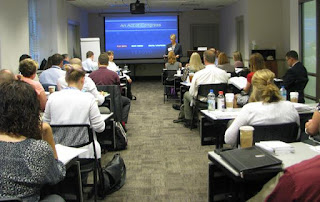One year ago, 35 BLM employees began a professional and personal development journey as part of the BLM's premier leadership development program. Leadership Academy is one of several employee development training programs offered by the BLM National Training Center (NTC) in Phoenix for employees desiring to advance their leadership skills.
The curriculum is organized around the Office of Personnel Management's (OPM's)
Executive Core Qualifications. These five qualifications – leading change, leading people, results driven, business acumen, and building coalitions – provide the framework for the OPM's 28 leadership competencies, which the BLM has endorsed.
 |
| The graduates of the 2015 BLM Leadership Academy. |
As recent graduate Richard Fields, Assistant Field Manager at the Oklahoma Field Office, stated, "BLM's Leadership Academy does not create leaders. They are drawn to the program. What it does, and does well, is give leaders the tools and training to be successful leaders for the BLM."
The participant's journey began at the NTC where participants spent a week assessing their leadership capabilities, learning how to apply leadership theories in practice, and developing strategies to help them become more effective leaders. From there, participants spent the next 10 months completing course assignments such as working on important team projects to benefit the BLM, presenting results of team projects to the Field Committee and Executive Leadership Team, completing a minimum 60-day detail, and shadowing and interviewing admired leaders.
 |
| Leadership Academy students in session. |
According to Richard White, Assistant Field Manager at the Vale District Office in Oregon, "Leadership Academy reinforced the importance of relationships and taking full advantage of every opportunity the BLM provides. The Academy expanded my network of colleagues who I can reach out to and created lifelong friendships."
Jeff Brune, Manager of BLM's Campbell Creek Science Center in Anchorage, Alaska, remarked, "My D.C. details with Public Affairs and the Division of Education, Interpretation, and Partnerships were fantastic! My projects were demanding, but we developed systems and products that I feel will bring value to the people of this great agency and the public we serve. I have a renewed sense of purpose for the BLM and for public service."
 |
Leadership Academy students in session.
|
Finally, after committing hundreds of hours and mountains of energy to complete the coursework and detail requirements, their journey ended in Washington DC with Political and Organizational Realities training. The training was capped off with inspiring speeches by DOI Assistant Secretary for Lands and Minerals Janice Schneider and BLM Deputy Director Steve Ellis, followed by the crescendo moment the participants eagerly anticipated – GRADUATION! Linda Lance, BLM's Acting Deputy Director of Planning and Resources, proudly confirmed their achievements with words of congratulations and handed out graduation certificates to each of the 35 Leadership Academy graduates.
When asked if all the effort and hard work was worth it, Leadership Academy graduate Michelle Ryerson, Field Manager at the Owyhee Field Office in Idaho, exclaimed, "Yes! It surpassed my expectations. I highly encourage future leaders of the BLM to participate!"
To learn more about the BLM's Leadership Academy, contact the National Training Center Leadership Academy Coordinator at 602-906-5628. Or, ask a recent Leadership Academy Graduate!
Congratulations to the members of the 2015 Leadership Academy Graduating Class:
Tauqeer Aslam
|
Amanda Dodson
|
Edward Kender
|
Gregory Miller
|
Charles Russell
|
Matthew Azhocar
|
Al Elser
|
Lori Kimball
|
Stephanie Miller
|
Michelle Ryerson
|
Jeff Brune
|
Paris Everson
|
Jeff Kitchens
|
Leanne Phillips
|
Robyn Shoop
|
Elizabeth Burghard
|
Richard Fields
|
Todd Kuck
|
Jill Ralston
|
Anna Sisson
|
Marjorie Chiles
|
Melissa Garcia
|
Eric Lepisto
|
Beth Ransel
|
Megan Stouffer
|
Byron Clayton
|
Lenore Heppler
|
Shane McDonald
|
Aaron Rasmussen
|
Richard White
|
Dana Dennison
|
Rebecca Hunt
|
Stacie McIntosh
|
Kimberly Rose
|
Kevin Wright
|
Story by Patti Klein, Acting Leadership Development Training Coordinator
****************************************
Reprinted from The BLM Daily from 10/20/15.




















